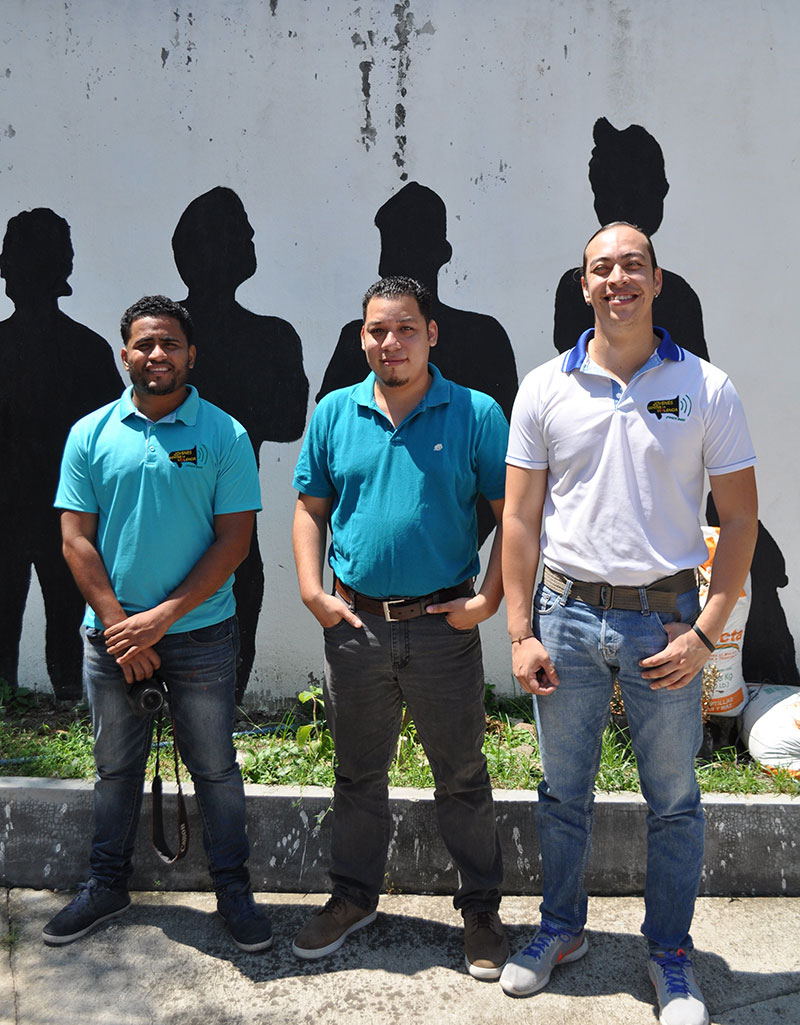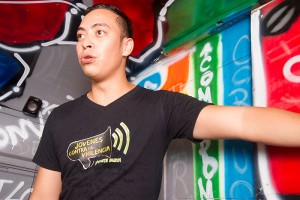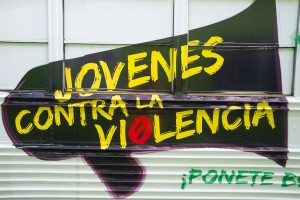The face of a youth anti-violence movement
By Jillian SlutzkerAugust 3, 2018
In crime-affected areas of Honduras, Santiago Avila offers youth an alternative to gangs
SAN PEDRO SULA – In the gang-dominated neighborhoods of Honduras, Santiago Avila is a force to be reckoned with. To the youth in his group, he is family. But if you breach his code, you can’t claim to be a member.
Avila, General Director of the country’s Youth Against Violence Movement (Jovenes Contra la Violencia in Spanish), operates a parallel structure to the gangs, recruiting youth, giving them a sense of belonging and purpose, and allowing then to put in time and climb the ranks. With successive volunteer hours, youth earn t-shirts, then caps, then polo shirts, all emblazoned with the group’s revered symbol: three soundwaves representing family, neighborhood and community.
“The metaphor [to gangs] is very emblematic,” says Avila. “These youth feel they can count on Jovenes Contra la Violencia for anything. That’s exactly what the gangs do.”

But as opposed to gangs, what binds this group together is a strict code of nonviolence and a dogged commitment to bringing hope and opportunity to their hard-hit comunities.
With more than 300 permanent members in seven high-violence cities, plus on an online community of 10,000, the Youth Against Violence Movement in Honduras has become the go-to advocacy group and thought leader on the country’s violence epidemic.
While the nation’s homicide rate dropped 26 percent in 2017 from 59.1 to 42.8 homicides per 100,000 residents, it is still among the highest in the world. Last year, 3,791 people were murdered, according to Insight Crime. Youth Against Violence Movement research reveals that typically 80 percent of homicide victims are ages 14 to 26.
The movement won’t stop until those numbers drop to zero.
They have consulted mayors and ministers, led nationwide campaigns and broadcast television programs that have elevated the issue of violence prevention in the halls of government and in living rooms across the country.
From a meeting to a movement
The success of the Youth Against Violence Movement today, however, is something Avila couldn’t have foreseen when he joined the budding group in 2010, just a year after it began in neighboring Guatemala as part of the Guatemala Youth Challenge Program, which was funded by the U.S. Agency for International Development and implemented by Creative Associates International.

Having lost his own brother to gang violence, Avila channeled his energy into the movement, which began as a close-knit team of youth with a big idea.
“For me, it was at first a family,” says Avila. “A family in which volunteers invest their time, their ideas and their talents and began to propose ideas that at one point we saw as a dream.”
A natural leader, Avila assumed second in command for the Honduras chapter behind the group’s then-leader Alejandra Hernandez, who now serves as the country’s Vice Minister for Security and Prevention.
With support from the private sector, the government and a youth violence prevention program funded by USAID and implemented by Creative called Alianza Joven Honduras (Youth Alliance Honduras), the movement quickly caught fire in Honduras.
Today it boasts chapters in in seven Central American countries.
Youth problems, youth solutions
Behind the movement’s success are a couple of simple, yet powerful ideas: 1) It is run by youth and for youth, the demographic bearing the brunt of the violence epidemic; 2) Even in the darkest of situations, there can be redemption and hope.
When Avila works with youth who have been branded “bad kids” or “criminals” from an early age or with the younger siblings of gang members—family gang affiliation being a known risk factor for gang-joining—he imagines something different and more positive for their lives than what most of society sees.

“We try to counter risk factors with protective factors,” says Avila. “Each person has the opportunity to construct his own future and life and that depends on attitudes. Always, even if there is very little, there is one opportunity.”
For these youth, the Youth Against Violence Movement is that opportunity. In their bright t-shirts, caps and polos—the uniform of nonviolence—the always-visible community volunteers offer an open invitation to those looking for a different cause to pledge allegiance to. The gangs see the group, keep tabs on their activities and largely leave them alone.
In their eight plus years, Avila and his movement have much to be proud of and much to celebrate. This year, new policies on prevention, arms and juvenile justice, on which the group advised lawmakers, are expected to be enacted. And the group is essentially a household name in the most high-violence neighborhoods, Avila says.
But perhaps one of the biggest achievements of the movement is something less tangible, but nonetheless profound and evident to those who matter most.
“We have changed the mentality of youth,” says Avila. “And that is important for them.”

